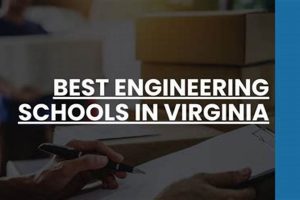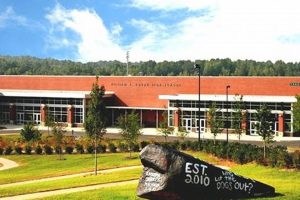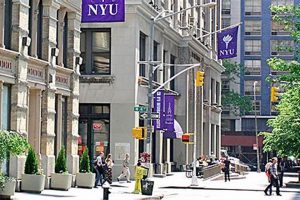Highly selective Division III institutions offer a distinct undergraduate experience, combining rigorous academic programs with a strong emphasis on extracurricular engagement, particularly in athletics. These colleges often attract students seeking a balanced educational approach, prioritizing intellectual development alongside competitive sports without the intensity and time commitment found in Division I programs. For example, a student might choose a Division III college known for its strong pre-med program while also playing soccer at a competitive intercollegiate level.
The value of this model lies in its ability to foster well-rounded individuals prepared for diverse career paths. Smaller class sizes and close faculty interaction often characterize the academic environment, promoting personalized attention and mentorship. Historically, the emphasis on a balanced educational experience within Division III stems from the philosophy of amateur athletics and the belief that participation in sports complements, rather than dominates, the pursuit of academic excellence. This focus often cultivates leadership skills, teamwork, and time management abilities, valuable assets for future endeavors.
Understanding the nuances of Division III institutions and their commitment to academic excellence alongside athletic pursuits is essential for prospective students. Exploring specific program offerings, faculty expertise, and athletic opportunities provides a clearer picture of the diverse landscape within Division III higher education.
Selecting a college that aligns with academic and personal aspirations requires careful consideration. The following tips offer guidance for students exploring Division III institutions.
Tip 1: Prioritize Academic Fit: Focus on institutions known for strength in intended majors or areas of academic interest. Investigate faculty expertise, research opportunities, and available resources within specific departments.
Tip 2: Evaluate Athletic Programs: Research coaching philosophies, team dynamics, and the level of competitiveness within the desired sport. Consider the time commitment required and its compatibility with academic pursuits.
Tip 3: Explore Campus Culture: Visit campuses to experience the environment firsthand. Attend classes, meet with current students and faculty, and observe the interaction between academics and athletics.
Tip 4: Consider Location and Size: Reflect on preferred geographic location, campus size, and overall student body demographics. These factors contribute significantly to the overall college experience.
Tip 5: Investigate Financial Aid and Scholarships: Explore available financial aid options, including merit-based scholarships and need-based grants. Understand the cost of attendance and develop a realistic financial plan.
Tip 6: Engage with Admissions Offices: Communicate directly with admissions representatives to demonstrate interest and gather specific information. Attend virtual information sessions and college fairs.
By considering these factors, prospective students can identify Division III institutions that offer a supportive environment for both academic and athletic success, fostering personal growth and preparing them for future opportunities.
Ultimately, selecting the right Division III college requires thorough research, self-reflection, and a clear understanding of personal priorities.
1. Rigorous Academic Programs
A defining characteristic of top Division III institutions is the presence of academically challenging programs. These programs cultivate intellectual curiosity, critical thinking, and advanced scholarship, preparing students for demanding graduate programs and professional careers. The rigor of these programs contributes significantly to the overall academic reputation and appeal of these institutions.
- Challenging Curriculum:
Rigorous academic programs often feature demanding curricula incorporating advanced coursework, independent study opportunities, and comprehensive examinations. For example, a physics program might require advanced laboratory work, original research projects, and a culminating thesis. This challenging curriculum fosters deep subject matter expertise and prepares students for the rigors of graduate study.
- High Faculty Expectations:
Faculty at institutions known for academic excellence maintain high expectations for student performance. This translates into demanding assignments, rigorous grading standards, and an emphasis on critical analysis and original thought. Students are challenged to push their intellectual boundaries and develop advanced analytical skills.
- Emphasis on Research and Scholarship:
Leading Division III colleges often prioritize undergraduate research and scholarship. Students have opportunities to engage in original research projects, collaborate with faculty mentors, and present their findings at conferences. This emphasis on research fosters intellectual independence and provides valuable experience for future academic pursuits.
- Focus on Critical Thinking and Problem-Solving:
Rigorous academic programs cultivate critical thinking and problem-solving abilities. Coursework emphasizes analytical reasoning, logical argumentation, and the ability to synthesize complex information. These skills are essential for success in graduate programs and a variety of professional fields.
These interconnected elements of rigorous academic programs contribute significantly to the overall academic environment and reputation of top Division III institutions. Graduates of these programs are well-prepared for the intellectual demands of graduate or professional study and possess the critical thinking skills necessary to thrive in a complex and ever-evolving world.
2. Faculty Expertise and Mentorship
Faculty expertise and mentorship are integral components of high-quality academic environments, particularly within Division III institutions. Close interaction with accomplished faculty members contributes significantly to student learning, intellectual growth, and career development. Dedicated mentorship fosters individual growth and creates opportunities for personalized guidance, often influencing students’ academic trajectories and future career paths.
For instance, a student interested in pursuing a research career benefits immensely from working closely with a faculty member actively engaged in cutting-edge research. This mentorship provides practical experience, fosters critical thinking skills, and builds essential professional networks. Similarly, a student uncertain about career options can benefit from guidance provided by experienced faculty members with diverse professional backgrounds. This personalized mentorship helps students explore various career paths and make informed decisions about their future.
Institutions prioritizing faculty mentorship demonstrate a commitment to student success beyond the classroom. This fosters a supportive learning environment where students feel empowered to explore their intellectual curiosity, seek guidance, and develop their full potential. The accessibility and dedication of faculty mentors significantly differentiate the academic experience at leading Division III institutions, enhancing their reputation for academic excellence.
3. Small Class Sizes
Small class sizes are a hallmark of many top-tier Division III institutions and contribute significantly to their academic reputation. This learning environment fosters personalized attention, encourages active participation, and promotes close interaction between students and faculty. The benefits of small class sizes extend beyond improved academic performance, impacting student engagement, intellectual curiosity, and overall educational satisfaction.
- Increased Student Engagement:
Smaller classes facilitate more active student participation. Opportunities for discussion, debate, and collaborative learning are amplified when class sizes are limited. In a small seminar on Shakespeare, for example, students might engage in in-depth analysis of a sonnet, fostering critical thinking and communication skills. This level of engagement is often difficult to achieve in larger lecture settings.
- Personalized Attention from Faculty:
Reduced class sizes allow faculty to provide more individualized attention to each student. This personalized feedback and mentorship can be invaluable, particularly in challenging subjects. A student struggling with organic chemistry, for instance, can benefit significantly from one-on-one guidance from a professor. This personalized approach enhances understanding and fosters deeper learning.
- Stronger Student-Faculty Relationships:
The intimate nature of small classes fosters stronger relationships between students and faculty. This close interaction creates a supportive learning environment where students feel comfortable seeking help, asking questions, and engaging in meaningful discussions outside of class. Such relationships can lead to valuable mentorship opportunities, research collaborations, and career guidance.
- Enhanced Collaboration and Peer Learning:
Small classes create opportunities for collaborative learning and peer interaction. Group projects, discussions, and peer feedback become more effective and engaging in smaller groups. Students learn from each other, develop teamwork skills, and build a sense of community within the classroom.
The emphasis on small class sizes within many Division III institutions underscores their commitment to providing a high-quality, student-centered learning experience. This focus on personalized instruction, enhanced engagement, and strong faculty-student relationships contributes significantly to the academic rigor and overall educational value offered by these institutions.
4. Research Opportunities
Undergraduate research opportunities represent a cornerstone of academic excellence within highly regarded Division III institutions. These experiences provide students with invaluable practical skills, foster intellectual curiosity, and contribute significantly to their overall academic development. The availability and quality of research opportunities directly correlate with an institution’s commitment to providing a rich and stimulating learning environment. Engaging in research allows students to apply classroom knowledge to real-world problems, develop critical thinking skills, and gain experience in experimental design, data analysis, and scientific communication. For example, a student at a leading liberal arts college might conduct research on the impact of climate change on local ecosystems, collaborating with faculty and presenting findings at a regional conference. This experience provides practical skills applicable to graduate programs and future careers in environmental science.
The benefits of undergraduate research extend beyond skill development. Early exposure to research fosters intellectual independence, encourages innovative thinking, and allows students to explore specific areas of academic interest in greater depth. Students working alongside experienced faculty mentors gain valuable insights into the research process, learn advanced methodologies, and develop professional networks within their chosen fields. Furthermore, participation in research can significantly enhance a student’s application to competitive graduate programs or professional schools, demonstrating a commitment to scholarship and a capacity for independent work. A student conducting research on artificial intelligence, for example, gains a competitive edge when applying to graduate programs in computer science. This hands-on experience demonstrates a deeper understanding of the field and a capacity for advanced study.
Institutions prioritizing undergraduate research cultivate an environment of intellectual exploration and discovery. These opportunities contribute significantly to the overall academic experience, fostering critical thinking, problem-solving skills, and a deeper understanding of the chosen field of study. The availability of resources, dedicated faculty mentorship, and opportunities for disseminating research findings are key indicators of a strong commitment to undergraduate research and contribute to the academic reputation of leading Division III colleges. Ultimately, the integration of research into the undergraduate curriculum enhances the educational experience and prepares students for success in a wide range of future endeavors.
5. Academic Resources and Facilities
Academic resources and facilities play a crucial role in defining the quality of education offered by Division III institutions. Access to state-of-the-art laboratories, well-stocked libraries, advanced technological infrastructure, and specialized equipment directly impacts students’ ability to engage in in-depth study, conduct meaningful research, and develop essential skills. A well-equipped astronomy department, for example, featuring a high-powered telescope and access to astronomical databases, enables students to engage in observational astronomy and data analysis, providing practical experience relevant to their field of study. Similarly, a writing center staffed with experienced tutors provides essential support for students developing critical writing and communication skills, regardless of their major. These resources contribute significantly to the overall academic experience and are often a key factor differentiating leading Division III institutions.
The availability of advanced resources facilitates high-impact learning experiences, fosters intellectual curiosity, and prepares students for the demands of graduate programs and professional careers. A modern language lab equipped with interactive software, for instance, allows students to develop fluency and pronunciation skills, enhancing their communicative competence. Likewise, a well-equipped engineering lab featuring 3D printers and computer-aided design software empowers students to design and prototype innovative solutions, bridging the gap between theory and practice. Investment in these resources demonstrates a commitment to providing students with the tools necessary to excel in their chosen fields.
Strategic investment in academic resources and facilities directly correlates with an institution’s commitment to academic excellence. These resources are not merely supplementary; they are essential components of a high-quality educational experience. Well-maintained facilities, access to cutting-edge technology, and readily available learning resources contribute to a positive learning environment, foster intellectual stimulation, and ultimately enhance student outcomes. The quality and accessibility of academic resources and facilities should be a key consideration for prospective students evaluating Division III institutions. This understanding allows for a more informed assessment of the institution’s commitment to academic rigor and its capacity to provide students with the tools they need to succeed academically and professionally.
6. Strong Alumni Network
A robust alumni network is a significant indicator of a successful academic institution, particularly within the context of Division III schools. A strong alumni network signifies not only the quality of education received but also the enduring connection graduates maintain with their alma mater. This network provides substantial benefits to current students, prospective students, and the institution itself, contributing to its reputation for academic excellence.
- Mentorship and Career Guidance:
Alumni networks offer current students invaluable mentorship opportunities and career guidance. Experienced alumni working in diverse fields can provide insights into specific career paths, offer advice on internships and job applications, and facilitate networking opportunities. For example, a recent graduate interested in finance could connect with alumni working in investment banking, gaining valuable industry knowledge and potentially securing an internship. This direct mentorship provides practical experience and fosters professional development.
- Internship and Job Opportunities:
Strong alumni networks often translate into increased internship and job opportunities for graduating students. Alumni frequently prioritize hiring graduates from their alma mater, recognizing the quality of education and shared institutional values. An alumnus working at a software company, for instance, might advocate for hiring a recent computer science graduate, creating a direct pipeline from the institution to the professional world. This network effect significantly enhances career prospects for graduates.
- Institutional Advancement and Support:
Active and engaged alumni networks often contribute financially to their alma mater, supporting scholarships, research initiatives, and facility upgrades. This financial support strengthens the institution’s resources, enhancing the academic experience for current and future students. Alumni donations might fund a new science lab, for example, providing cutting-edge equipment for student research. This philanthropic engagement reinforces the cycle of excellence within the institution.
- Enhanced Reputation and Prestige:
A thriving alumni network reflects positively on the institution’s reputation and prestige. The success of alumni in various fields serves as a testament to the quality of education and preparation provided by the institution. This enhanced reputation attracts prospective students and faculty, further strengthening the academic community. The achievements of alumni in fields such as medicine, law, and academia, for instance, elevate the institution’s academic standing and contribute to its overall prestige.
A strong alumni network, therefore, represents a crucial component of a high-quality Division III education. It provides tangible benefits to students, strengthens the institution’s resources, and enhances its overall reputation. Prospective students considering Division III institutions should carefully evaluate the strength and engagement of the alumni network as an indicator of the institution’s commitment to student success beyond graduation. This network serves as a vital link between academic preparation and professional achievement, contributing significantly to the long-term value of a Division III education.
7. Successful Career Outcomes
Successful career outcomes are a critical measure of an institution’s academic effectiveness, particularly within the Division III landscape. These outcomes reflect not only the rigor of academic programs but also the institution’s commitment to preparing students for diverse career paths. Analyzing career outcomes provides valuable insights into the long-term value of a Division III education and its impact on students’ professional trajectories. Factors such as placement rates in graduate or professional schools, career placement in chosen fields, and alumni achievements contribute to a comprehensive understanding of an institution’s success in preparing students for fulfilling careers.
- Graduate and Professional School Placement:
High placement rates in selective graduate and professional programs signify the strength of undergraduate preparation provided by Division III institutions. For example, a high percentage of pre-med graduates gaining acceptance to top medical schools reflects positively on the rigor of the undergraduate biology program and the quality of advising provided. This success underscores the effectiveness of the institution in preparing students for advanced study in demanding fields.
- Career Placement in Chosen Fields:
Successful placement of graduates in their chosen fields demonstrates the practical relevance of the education received. A high percentage of computer science graduates securing software engineering positions, for instance, indicates the program’s alignment with industry needs and its effectiveness in equipping students with the necessary skills. This direct correlation between academic preparation and career outcomes validates the institution’s commitment to career readiness.
- Alumni Career Trajectories and Achievements:
Tracking alumni career trajectories and achievements provides a longitudinal perspective on the long-term impact of a Division III education. Alumni success in leadership positions, entrepreneurial ventures, and contributions to their respective fields reflects positively on the institution’s ability to foster intellectual growth and professional development. For example, alumni achieving recognition for their contributions to scientific research or founding successful companies demonstrates the lasting impact of the institution’s commitment to academic excellence.
- Development of Transferable Skills:
Successful career outcomes often correlate with the development of transferable skills such as critical thinking, communication, problem-solving, and teamwork. Division III institutions, with their emphasis on small class sizes, close faculty interaction, and opportunities for research and leadership, often cultivate these essential skills. These transferable skills enhance graduates’ adaptability and prepare them for success in diverse career paths, regardless of their specific major. For example, a history graduate with strong analytical and communication skills might pursue a career in law, journalism, or public policy.
Evaluating successful career outcomes provides a comprehensive understanding of the effectiveness of a Division III education in preparing students for fulfilling and impactful careers. These outcomes reflect the quality of academic programs, the strength of faculty mentorship, and the institution’s commitment to fostering intellectual growth and professional development. Prospective students seeking a rigorous academic experience that translates into meaningful career opportunities should carefully consider these outcomes when evaluating Division III institutions. Ultimately, successful career outcomes serve as a testament to the enduring value and transformative potential of a Division III education.
Frequently Asked Questions
Addressing common inquiries regarding academically focused Division III institutions provides clarity for prospective students seeking a balanced educational experience.
Question 1: How does the academic rigor of Division III institutions compare to Division I schools?
Academic rigor varies significantly within both Division I and Division III. Many Division III institutions prioritize academic excellence and offer highly challenging programs comparable to those found in selective Division I universities. The key difference lies in the emphasis on a balanced approach, allowing students to pursue both academic and athletic pursuits without one overshadowing the other.
Question 2: Are athletic scholarships available at Division III schools?
Athletic scholarships are not offered at Division III institutions. Financial aid is awarded based on need and academic merit, ensuring equitable access to education regardless of athletic ability.
Question 3: What is the typical class size at a Division III college?
Class sizes at Division III institutions are generally small, often averaging between 15-20 students. This allows for personalized attention from faculty, increased student participation, and a more intimate learning environment.
Question 4: What types of research opportunities are available for undergraduates at Division III schools?
Many Division III colleges prioritize undergraduate research, offering students opportunities to work closely with faculty on diverse projects. These experiences can span various disciplines, from scientific research in state-of-the-art laboratories to humanities research utilizing archival resources.
Question 5: How does the time commitment for athletics differ between Division I and Division III?
While Division III athletes are highly competitive, the time commitment is generally less demanding than in Division I. This allows students to maintain a healthy balance between academics, athletics, and other extracurricular activities.
Question 6: What are the career outcomes for graduates of academically focused Division III institutions?
Graduates of strong academic Division III programs often achieve successful career outcomes, pursuing advanced degrees at prestigious institutions and securing positions in diverse fields. The emphasis on critical thinking, communication, and problem-solving skills, coupled with opportunities for research and leadership development, prepares graduates for a wide range of career paths.
Careful consideration of these frequently asked questions clarifies common misconceptions surrounding Division III institutions and emphasizes the potential for a fulfilling and academically challenging undergraduate experience.
Exploring specific institutional profiles, visiting campuses, and engaging directly with admissions representatives further inform the decision-making process for prospective students.
Finding the Right Fit
Navigating the landscape of higher education requires careful consideration of individual priorities and aspirations. For students seeking a balanced approach, prioritizing academic rigor alongside athletic pursuits, highly selective Division III institutions offer a distinct advantage. The combination of challenging academic programs, close faculty interaction, and a vibrant athletic environment fosters well-rounded development, preparing students for diverse career paths and lifelong learning. Key factors such as small class sizes, research opportunities, dedicated faculty mentorship, and access to advanced resources contribute significantly to the academic excellence found within leading Division III colleges. Successful career outcomes, including high placement rates in graduate programs and competitive job markets, further underscore the long-term value of this educational model.
Ultimately, the pursuit of academic excellence within the context of Division III athletics requires a thoughtful and informed approach. Thorough research, self-reflection, and a clear understanding of personal values and goals are essential for identifying the optimal institutional fit. By carefully evaluating academic programs, exploring campus cultures, and engaging with current students and faculty, prospective students can discover institutions that champion both academic and athletic achievement, fostering personal growth and empowering them to reach their full potential.







